
Electrochemical Test Fixture for Solid Electrolyte Cells
💡 Engineered for scientific research, this device simulates the real pressure conditions of solid-state electrolyte cells for precise electrochemical performance evaluation.
The BM01 mold kit is a laboratory device designed for research on solid-state lithium-ion batteries.
(⚠️ Note: Pressure sensors and control systems not included by default.)
It simulates actual pressure conditions in solid-state batteries and supports various electrolyte materials for two- and three-electrode systems. Ideal for testing conductivity, impedance, and general electrochemical behavior under controlled pressure.
🧪 Compatible with the BS01 Multi-Channel Solid State Battery Pressure Test System. Each channel supports independent pressure settings, synchronized operation, and individual data export—perfect for comparative studies.
| Component | Qty | Component | Qty |
|---|---|---|---|
| Threaded rods | 3 | Top & bottom metal pressing disks | 2 |
| Electrode rods | 2 | Locking bolts | 3 |
| O-rings | Several | PEEK or ceramic insulation sleeve | 1 |
| PPS protective set | 1 | PEEK insulating covers | 2 |
| Copper rods + wires | Several | Wire pair with banana/alligator clips | 1 set |
| Model | Chamber Diameter | Shell Diameter | Total Height | Weight |
|---|---|---|---|---|
| BM01-06 | 6 mm | 90 mm | 130 mm | ≈ 2 kg |
| BM01-10 | 10 mm | 90 mm | 130 mm | ≈ 2 kg |
| BM01-12 | 12 mm | 90 mm | 130 mm | ≈ 2 kg |
| BM01-15 | 15 mm | 90 mm | 130 mm | ≈ 2 kg |
| BM01-20 | 20 mm | 90 mm | 130 mm | ≈ 2 kg |
| ✔️ Custom sizes available on request. | ||||
Example (BM01-10):
Inner Chamber (with PPS sleeve): Ø40 mm
Cavity Diameter: 10 mm
Total Assembly Height: 130 mm
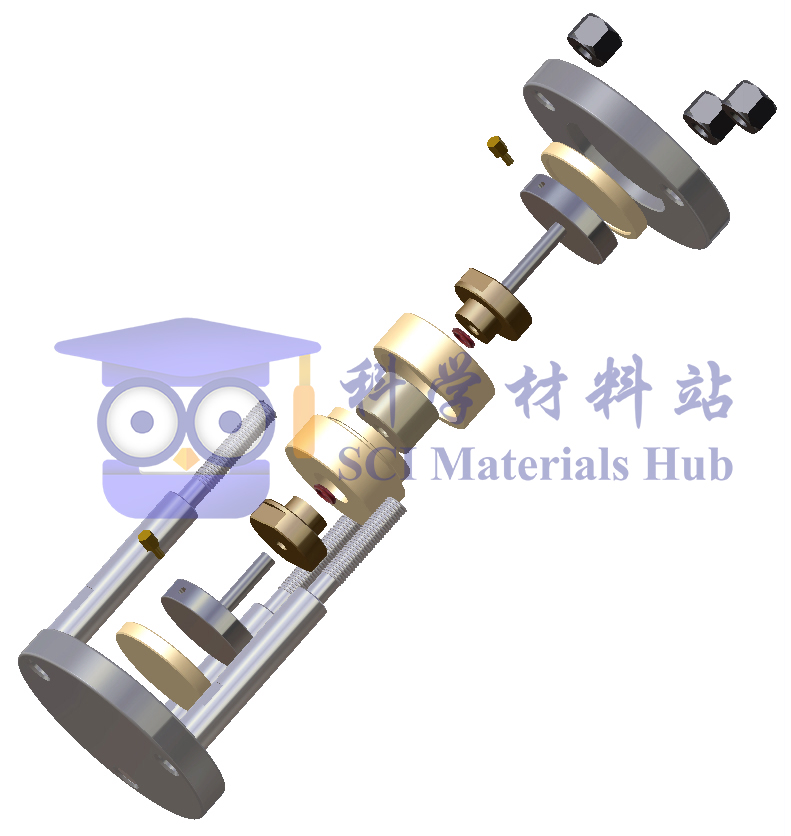
✅ Excellent Sealing: Double O-ring system with Teflon contact seals provides superior leak resistance compared to conventional PEEK seals.
✅ High Pressure Stability: Supports up to 300 MPa long-term; tested up to 400 MPa under controlled conditions.
✅ Wide Thermal Compatibility: Safe for continuous use from –40°C to 200°C, suitable for various electrolyte and binder systems.
✅ Easy Sample Handling: User-friendly disassembly/assembly process—ideal for glovebox operation and rapid sample exchange.
✅ Precision Ground Contacts: All pressing and electrode interfaces are flat-milled for enhanced contact and reproducibility.
✅ Cost-Effective: Durable material selection + replaceable parts = long service life and lower cost of ownership for research labs.
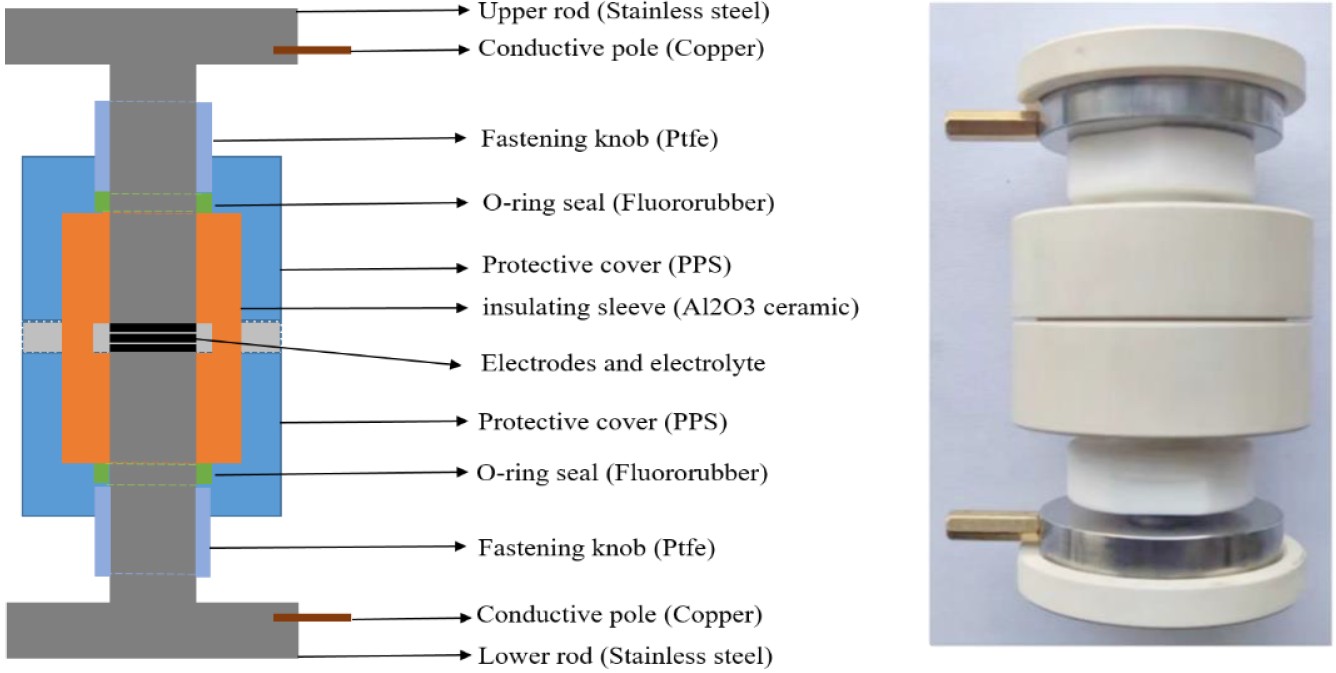
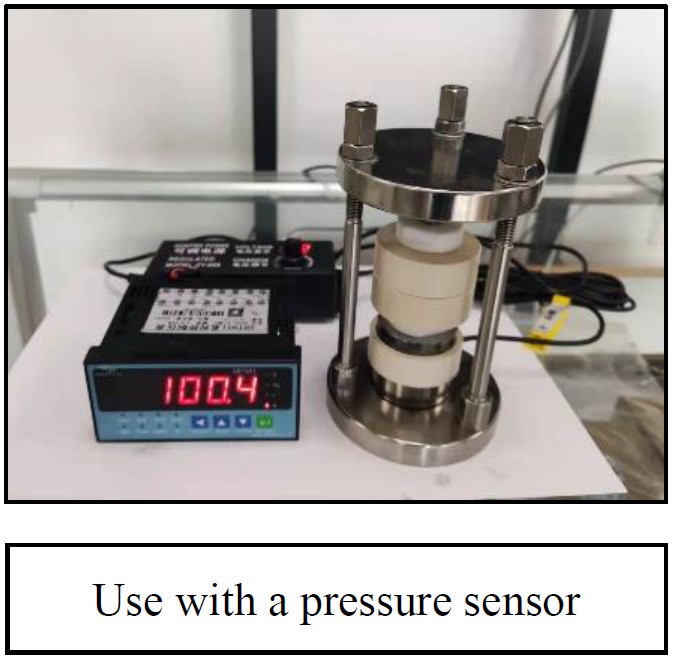
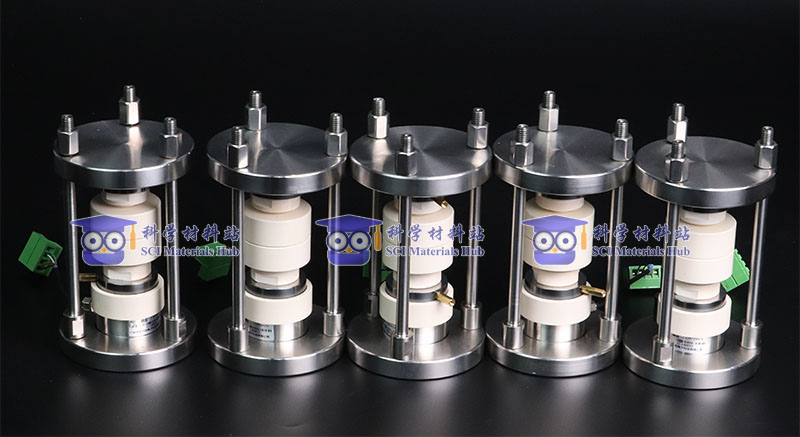
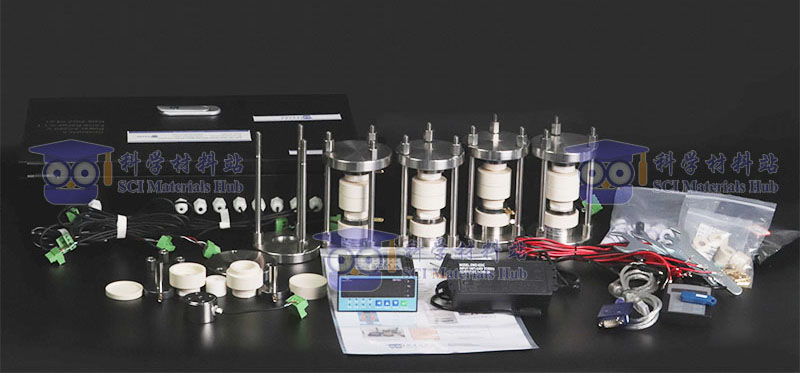
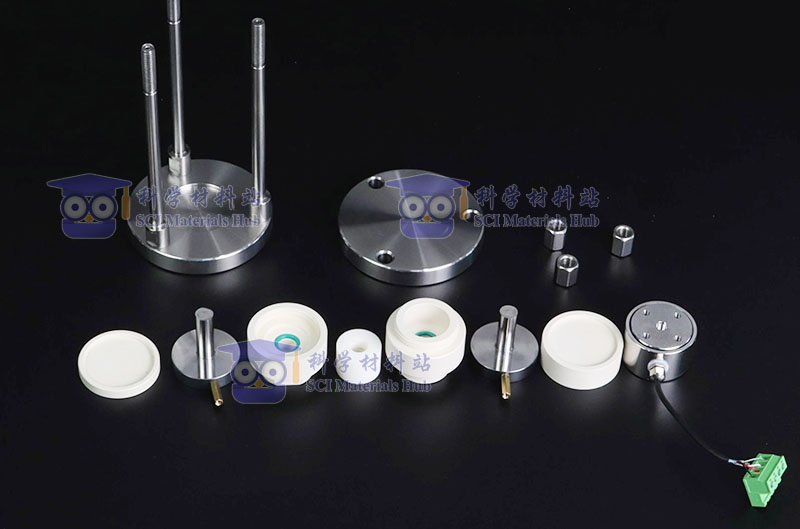
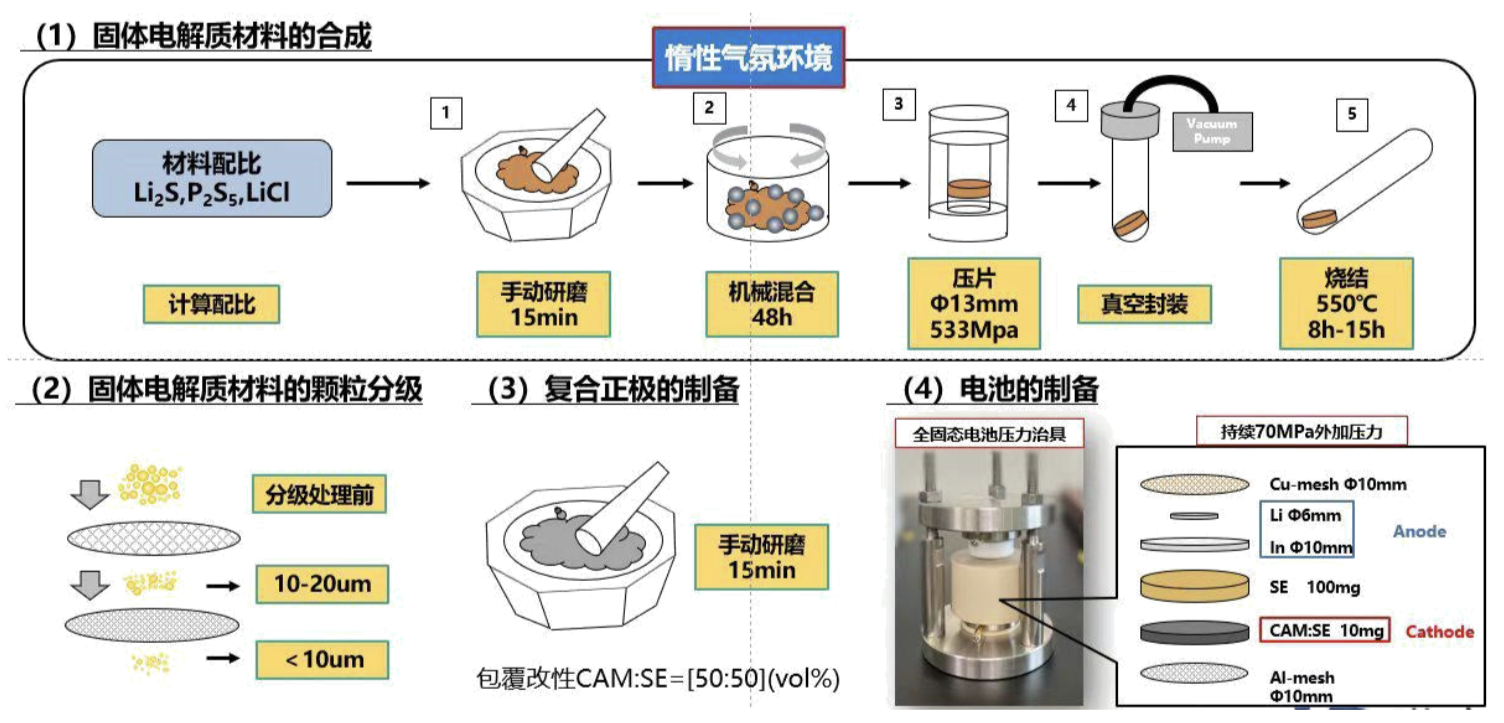
Typical Testing Range: 80–150 MPa
With Lithium/Indium foils: Recommend < 80 MPa
1-ton press ≈ 125 MPa pressure inside mold
High-load version (with tungsten carbide rods): pressure tolerance up to 1000 MPa (1 GPa)
Step-by-step Workflow:
Place the mold base inside the glovebox
Load solid electrolyte sample into the chamber
Lower the press rod using a powder press or screw rotation
Apply desired pressure
Lock screws on top to maintain seal
Remove mold for ex-situ testing (optional: apply vacuum grease to reduce leakage)
Mold insulation: Ceramic or PEEK sleeve
Outer protection: PPS high-strength shell
Electrodes: Hardened mold steel
Modular build: Easy replacement of wear parts (seals, screws, insulation sleeve)
Must operate entire process within an inert glovebox
Do not exceed the maximum working pressure per model
After use:
Clean powder residues
Wipe with alcohol
Apply grease on pressing rods
Use rubber caps to prevent oxidation
Store in a dry, sealed environment
Never exceed pressure ratings (varies by chamber size)
Always tighten screws after reaching target pressure
Use with transfer fixtures for safe transport and long-term pressure holding
Replace consumables (O-rings, insulation sleeves, rods) as needed—contact support for spares
Q1: How to apply accurate pressure?
Use a torque wrench or a mechanical press. Once target pressure is reached, manually tighten top bolts to lock in place.
Q2: Can I test conductivity under varying pressure?
Yes. You can perform conductivity or EIS testing under different pressure values and export data for comparison.
Q3: How to maintain stable pressure during testing?
For pressures below 100 MPa, a spring-loaded buffer can be added to minimize pressure drift over time.
📲 Contact us for CAD drawings, custom dimensions, or full testing system integration support.
📦 Small-batch trials and bulk orders supported.
📧 Email: contact@scimaterials.cn
📞 Tel: +86 153-7569-8751
🔗 Click to place quick orders via our eBay / Amazon / Alibaba stores.
🌐 We ship worldwide via DHL, FedEx, UPS, SF-Express, or other requested carriers.
📦 Bulk quantities with discount available upon request.
💳 Payment methods accepted: Bank Wire Transfer, PayPal, Credit Card (via Taobao), Alipay, WeChat Pay
| Model | Chamber Diameter (mm) | Total Height (with rod, mm) | Outer Diameter (mm) | Electrode Material | Price (USD) |
|---|---|---|---|---|---|
| BM01-06 | 6 | 130 | 90 | Mold Steel | $599 |
| BM01-10 | 10 | 130 | 90 | Mold Steel | $599 |
| BM01-12 | 12 | 130 | 90 | Mold Steel | $599 |
| BM01-15 | 15 | 130 | 90 | Mold Steel | $599 |
| BM01-20 | 20 | 130 | 90 | Mold Steel | $599 |
| BM01-06W | 6 | 130 | 90 | Tungsten Carbide with Co | $699 |
| BM01-10W | 10 | 130 | 90 | Tungsten Carbide with Co | $699 |
| BM01-12W | 12 | 130 | 90 | Tungsten Carbide with Co | $699 |
| BM01-15W | 15 | 130 | 90 | Tungsten Carbide with Co | $699 |
| BM01-20W | 20 | 130 | 90 | Tungsten Carbide with Co | $699 |
All models come standard with a ceramic insulation sleeve.
PEEK inner sleeves are available upon request (please specify when ordering).
Prices include one full standard kit, as listed in the Product Configuration Table.
Customization available for:
Chamber diameter and shape (cylindrical, square, etc.)
Outer frame dimensions and fixing hole positions
Electrode interface design (banana plugs, bolts, etc.)
Optional integration with pressure sensors or electrical feedthroughs
Bulk purchases and custom research orders are supported.
Please contact us for quotations or special project collaborations.
Partial references citing our materials (from Google Scholar)
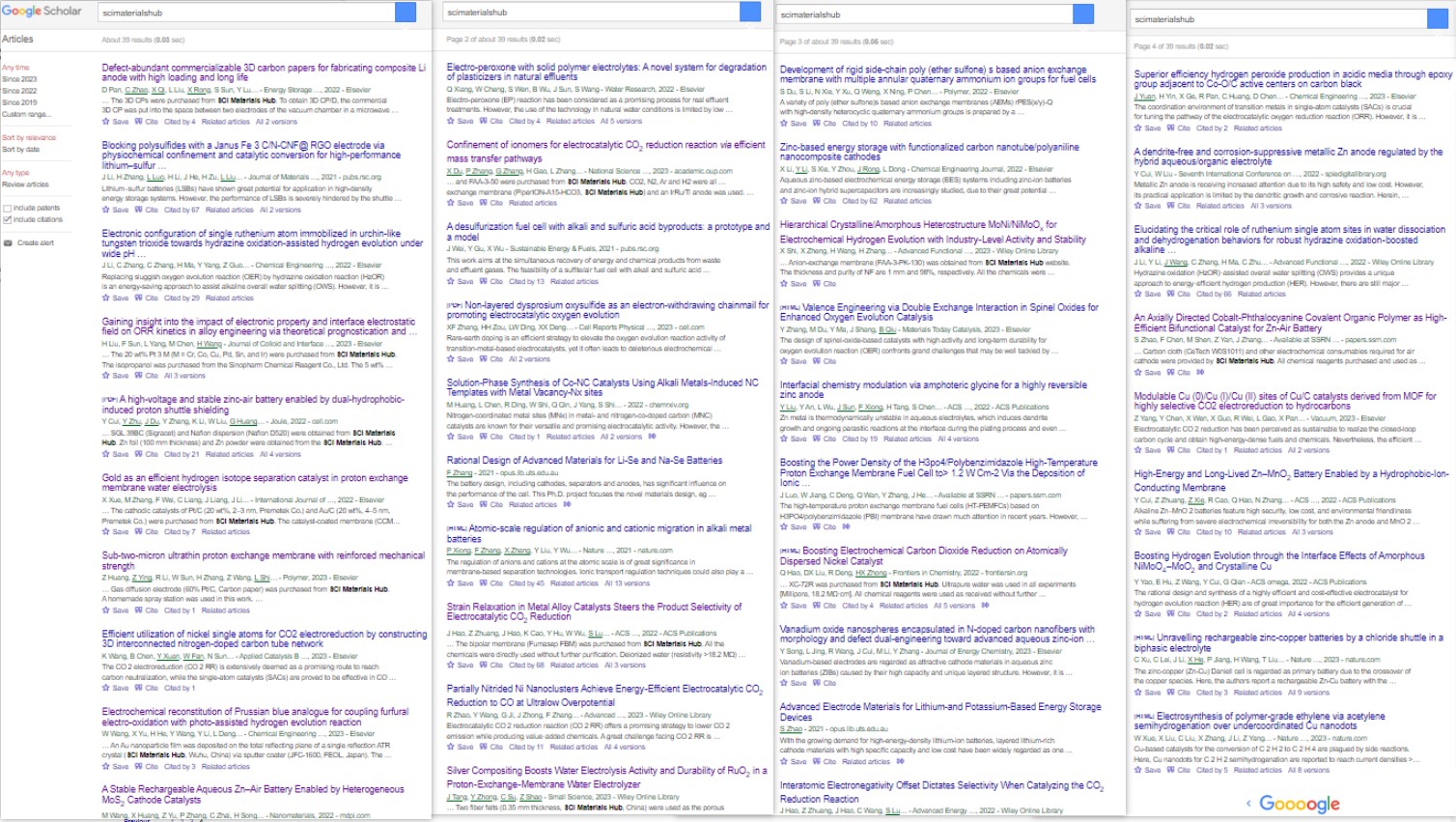
Carbon Dioxide Reduction
1. ACS Nano Strain Relaxation in Metal Alloy Catalysts Steers the Product Selectivity of Electrocatalytic CO2 Reduction
The bipolar membrane (Fumasep FBM) in this paper was purchased from SCI Materials Hub, which was used in rechargeable Zn-CO2 battery tests. The authors reported a strain relaxation strategy to determine lattice strains in bimetal MNi alloys (M = Pd, Ag, and Au) and realized an outstanding CO2-to-CO Faradaic efficiency of 96.6% with outstanding activity and durability toward a Zn-CO2 battery.
2. Front. Chem. Boosting Electrochemical Carbon Dioxide Reduction on Atomically Dispersed Nickel Catalyst
In this paper, Vulcan XC-72R was purchased from SCI Materials Hub. Vulcan XC 72R carbon is the most common catalyst support used in the anode and cathode electrodes of Polymer Electrolyte Membrane Fuel Cells (PEMFC), Direct Methanol Fuel Cells (DMFC), Alkaline Fuel Cells (AFC), Microbial Fuel Cells (MFC), Phosphoric Acid Fuel Cells (PAFC), and many more!
3. Adv. Mater. Partially Nitrided Ni Nanoclusters Achieve Energy-Efficient Electrocatalytic CO2 Reduction to CO at Ultralow Overpotential
An AEM membrane (Sustainion X37-50 Grade RT, purchased from SCI Materials Hub) was activated in 1 M KOH for 24 h, washed with ultra-purity water prior to use.
4. Adv. Funct. Mater. Nanoconfined Molecular Catalysts in Integrated Gas Diffusion Electrodes for High-Current-Density CO2 Electroreduction
In this paper (Supporting Information), an anion exchanged membrane (Fumasep FAB-PK-130 obtained from SCI Materials Hub (www.scimaterials.cn)) was used to separate the catholyte and anolyte chambers.
SCI Materials Hub: we also recommend our Fumasep FAB-PK-75 for the use in a flow cell.
5. Appl. Catal. B Efficient utilization of nickel single atoms for CO2 electroreduction by constructing 3D interconnected nitrogen-doped carbon tube network
In this paper, the Nafion 117 membrane was obtained from SCI Materials Hub.
In this paper, Proton exchange membrane (Nafion 117), Nafion D520, and Toray 060 carbon paper were purchased from SCI Materials Hub.
7. National Science Review Confinement of ionomer for electrocatalytic CO2 reduction reaction via efficient mass transfer pathways
An anion exchange membrane (PiperION-A15-HCO3) was obtained from SCI Materials Hub.
8. Catalysis Communications Facilitating CO2 electroreduction to C2H4 through facile regulating {100} & {111} grain boundary of Cu2O
Carbon paper (TGPH060), membrane solution (Nafion D520), and ionic membrane (Nafion N117) were obtained from Wuhu Eryi Material Technology Co., Ltd (a company under SCI Materials Hub).
Batteries
1. J. Mater. Chem. A Blocking polysulfides with a Janus Fe3C/N-CNF@RGO electrode via physiochemical confinement and catalytic conversion for high-performance lithium–sulfur batteries
Graphene oxide (GO) in this paper was obtained from SCI Materials Hub. The authors introduced a Janus Fe3C/N-CNF@RGO electrode consisting of 1D Fe3C decorated N-doped carbon nanofibers (Fe3C/N-CNFs) side and 2D reduced graphene oxide (RGO) side as the free-standing carrier of Li2S6 catholyte to improve the overall electrochemical performance of Li-S batteries.
This paper used more than 10 kinds of materials from SCI Materials Hub and the authors gave detailed properity comparsion.
The commercial IEMs of Fumasep FAB-PK-130 and Nafion N117 were obtained from SCI Materials Hub.
Gas diffusion layers of GDL340 (CeTech) and SGL39BC (Sigracet) and Nafion dispersion (Nafion D520) were obtained from SCI Materials Hub.
Zn foil (100 mm thickness) and Zn powder were obtained from the SCI Materials Hub.
Commercial 20% Pt/C, 40% Pt/C and IrO2 catalysts were also obtained from SCI Materials Hub.
3. Journal of Energy Chemistry Vanadium oxide nanospheres encapsulated in N-doped carbon nanofibers with morphology and defect dual-engineering toward advanced aqueous zinc-ion batteries
In this paper, carbon cloth (W0S1011) was obtained from SCI Materials Hub. The flexible carbon cloth matrix guaranteed the stabilization of the electrode and improved the conductivity of the cathode.
4. Energy Storage Materials Defect-abundant commercializable 3D carbon papers for fabricating composite Li anode with high loading and long life
The 3D carbon paper (TGPH060 raw paper) were purchased from SCI Materials Hub.
5. Nanomaterials A Stable Rechargeable Aqueous Zn–Air Battery Enabled by Heterogeneous MoS2 Cathode Catalysts
Nafion D520 (5 wt%), and carbon paper (GDL340) were received from SCI-Materials-Hub.
Carbon cloth (W0S1011) and other electrochemical consumables required for air cathode were provided by SCI Materials Hub.
Oxygen Reduction Reaction
1. J. Chem. Eng. Superior Efficiency Hydrogen Peroxide Production in Acidic Media through Epoxy Group Adjacent to Co-O/C Active Centers on Carbon Black
In this paper, Vulcan XC 72 carbon black, ion membrane (Nafion N115, 127 μL), Nafion solution (D520, 5 wt%), and carbon paper (AvCarb GDS 2230 and Spectracarb 2050A-1050) were purchased from SCI Materials Hub.
2. Journal of Colloid and Interface Science Gaining insight into the impact of electronic property and interface electrostatic field on ORR kinetics in alloy engineering via theoretical prognostication and experimental validation
The 20 wt% Pt3M (M = Cr, Co, Cu, Pd, Sn, and Ir) were purchased from SCI Materials Hub. This work places emphasis on the kinetics of the ORR concerning Pt3M (M = Cr, Co, Cu, Pd, Sn, and Ir) catalysts, and integrates theoretical prognostication and experimental validation to illuminate the fundamental principles of alloy engineering.
Water Electrolysis
1. International Journal of Hydrogen Energy Gold as an efficient hydrogen isotope separation catalyst in proton exchange membrane water electrolysis
The cathodic catalysts of Pt/C (20 wt%, 2–3 nm) and Au/C (20 wt%, 4–5 nm) were purchased from SCI Materials Hub.
2. Small Science Silver Compositing Boosts Water Electrolysis Activity and Durability of RuO2 in a Proton-Exchange-Membrane Water Electrolyzer
Two fiber felts (0.35 mm thickness, SCI Materials Hub) were used as the porous transport layers at both the cathode and the anode.
3. Advanced Functional Materials Hierarchical Crystalline/Amorphous Heterostructure MoNi/NiMoOx for Electrochemical Hydrogen Evolution with Industry-Level Activity and Stability
Anion-exchange membrane (FAA-3-PK-130) was obtained from SCI Materials Hub website.
Fuel Cells
1. Polymer Sub-two-micron ultrathin proton exchange membrane with reinforced mechanical strength
Gas diffusion electrode (60% Pt/C, Carbon paper) was purchased from SCI Materials Hub.
Characterization
1. Chemical Engineering Journal Electrochemical reconstitution of Prussian blue analogue for coupling furfural electro-oxidation with photo-assisted hydrogen evolution reaction
An Au nanoparticle film was deposited on the total reflecting plane of a single reflection ATR crystal (SCI Materials Hub, Wuhu, China) via sputter coater.

|
We Provide A Broad Range of Materials, Instruments & Solutions in Advanced Science and Technologies | About Us |



